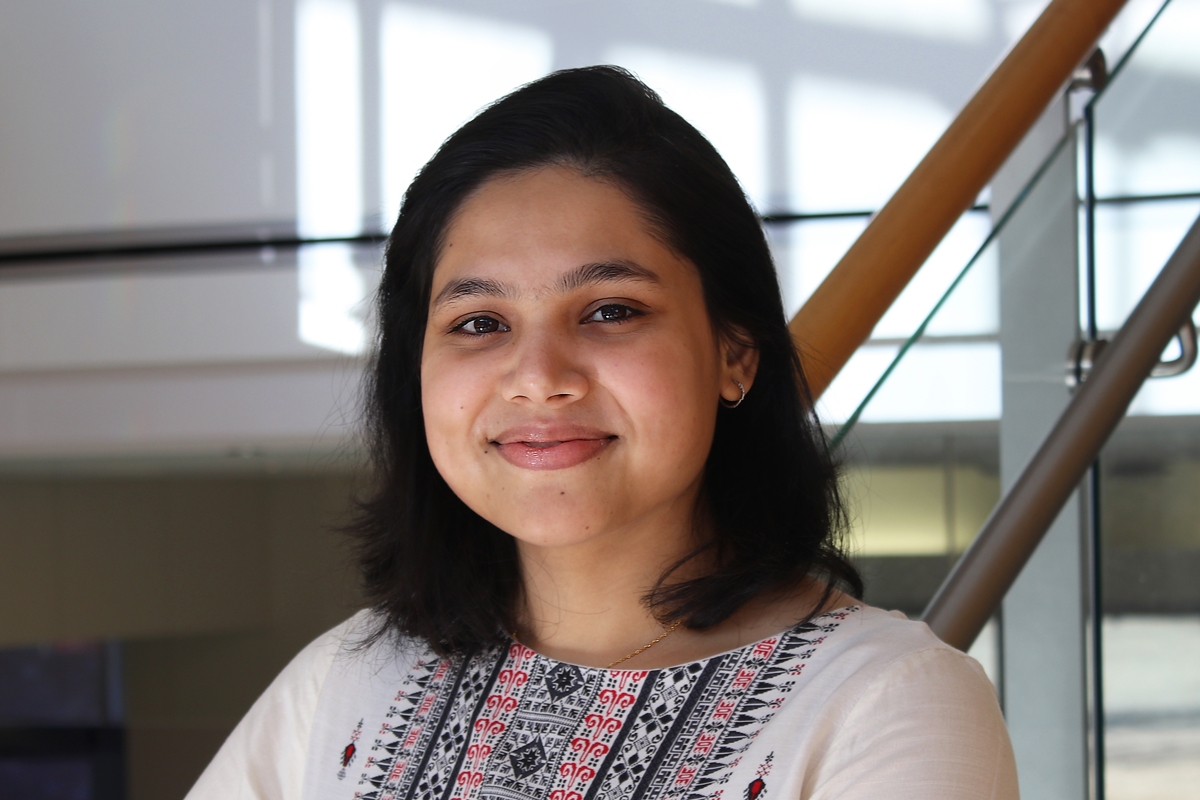When Chhandosee Ganguly was in 4th grade, a class assignment shifted the entire trajectory of her professional career.
“In school, we had a competition where you dressed up as your future profession and made a model of something related to that profession. Being from India, most of the parents expect their child to become a medical doctor or an engineer. My path was also set to become a doctor, but then one of my friends brought an interesting model of a scientist,” she said. “He had all the colorful liquids, test tubes and beakers in his model. My parents had made me a model with a nice little hospital bed and gave me a stethoscope, but both of us were wearing white lab coats, so I went ahead and exchanged our models. I think that was the first time I got interested in becoming a scientist.”
Ganguly has come a long way from swapping classroom assignments. Her friend’s scientist model illustrated a path toward her becoming the kind of doctor she most wanted.
When applying for doctoral programs, she connected with the faculty involved in her interview panel at the University of Oklahoma.
“I was very interested in the different types of interdisciplinary research happening here,” she said. “There are no two professors doing the same research in this department, which was very interesting to me.”
Now in her fourth year of a doctoral program, she is working under the mentorship of Rakhi Rajan, an associate professor in the Department of Chemistry and Biochemistry, to improve the efficacy and safety of CRISPR Cas9 and Cas12.
CRISPR, which stands for Clustered Regularly Interspaced Short Palindromic Repeats, is a revolutionary gene-editing technology derived from the immune system of bacteria. It allows scientists to make precise changes to an organism's DNA, offering a cheaper, more accurate and more efficient method of genome editing compared to other techniques. The CRISPR-Cas9 system, the most well-known form of CRISPR, consists of a nuclease protein (Cas9) guided by an RNA to target and modify specific DNA sequences. This technology has a wide range of applications, from fundamental research to potential clinical treatments for various genetic and infectious diseases.
Emmanuelle Charpentier and Jennifer A. Doudna received the 2020 Nobel Prize in Chemistry for the development of CRISPR-Cas9, a method for genome editing. They became the first female team to receive this prize out of the 186 Nobel Prize laureates in Chemistry. At the time, they were only the sixth and seventh women to be acknowledged with the award. Ganguly considers these Nobel women laureates and Dr. Rajan her sources of inspiration and guiding lights.
“When we are using Cas proteins for gene editing, we want it to be extremely precise. In the current form, there is no 100% fidelity, meaning Cas9 can wrongly edit unintended regions of the genome, commonly called as off-target editing. We don't want off-target activity when administering Cas proteins for gene editing,” she said. “Currently, in the lab, my goal is to understand the atomic structures of these proteins. We are using CryoEM microscopy to image them and study their structures to decipher the functional mechanism of Cas9 and Cas12 proteins to remove off-target editing.”
With Cryo-electron microscopy, or CryoEM, researchers can obtain high-resolution images of biological macromolecules such as proteins, DNA and RNA. It involves freezing the biological sample in a thin layer of vitreous ice and then imaging it using an electron microscope under cryogenic conditions. This method allows scientists to visualize the detailed 3D structures of proteins, DNA, RNA, viruses and cells at near-atomic resolution, revealing their shapes and interactions.
“When I started my rotation at Dr. Rajan’s lab, I still remember the first day I was introduced to CryoEM, which got me super excited because it was something very new for me,” she said.
In 2023, Ganguly studied CryoEM at two national facilities: Stanford-SLAC Cryo-EM Center (S2C2) National Lab and National Center for CryoEM Access and Training (NCCAT), supported by OU’s Oklahoma COBRE in Structural Biology.
“That was a great opportunity for me to learn this new technology from some of best CryoEM scientists in the country,” she said. “Now, OU is getting our own CryoEM microscope, which will allow us to elucidate dynamic structures of complex proteins and contribute to the development of therapies for genetic diseases.”
The future of CRISPR holds nearly unfathomable possibilities, but regardless of the subject a student is interested in, Ganguly said the most important thing is for students to believe in themselves.
“A lot of girls are scared to take STEM classes,” she said. “Girls will end up in the humanities because they think science is not our thing, that they cannot do science. That's not true. There is nothing a woman cannot do. You just need to give it a try. Once you give it a try, you can do it.”
For students interested in higher education, Ganguly suggests looking at an institution’s research as the most important factor in making their decision.
“When you're applying to a doctoral program, or you think you’re interested in research as your career, look into the research opportunities with an open mind to discover their full potential and broader scope,” she said. “The research that is going on here at OU is incredible.”


